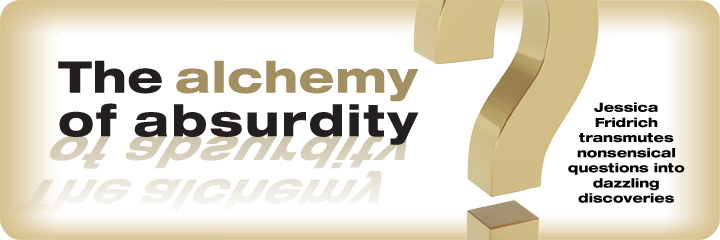
Many researchers have spent their careers asking different iterations of the question “Why?” Jessica Fridrich established a place for herself and remains in the vanguard of her field by asking the more audacious question “Why not?”
Fridrich is known the world over for developing brilliant new approaches to problems involving information hiding in digital imagery. Her areas of expertise include digital image authentication, tamper detection, robust watermarking, steganalysis and steganography. Colleagues characterize her work as relentless in its originality and spectacular in its fecundity.
Her 12-year tenure at Binghamton University, where she is a professor in the Thomas J. Watson School of Engineering and Applied Science, includes an unbroken string of externally sponsored research projects that have given rise to five U.S. and international patents, as well as two pending patent applications. Law enforcement agencies, movie makers and government officials all want to know what she’s doing next because her work has such important implications in the fights against terrorism, child pornography, counterfeiting and digital piracy.

“A lot of big discoveries come out of trying to do the impossible,” Fridrich said. “So in my research group, we often start by asking stupid, silly questions. We look at what is thought to be impossible and say, ‘Can we do this?’ Anyone who listened to us would say, ‘These guys are nuts. Of course you can’t do this. What a silly question.’”
Time and again, however, Fridrich has demonstrated that entertaining seemingly ridiculous questions, while daring to ask “why not,” just might be the smartest thing a researcher can do. That’s what happened seven years ago, she recalls, when during a presentation on steganography — the art of hiding information — she was asked if she could hide something in a digital image without altering the original image.
Her first thought, she now admits, was “That’s nonsense.” But rather than stopping there, she began to devise permutations that would allow her to do what seemed impossible at first blush.
On the occasion in question, the result of her willful disregard for the presumed bounds of possibility was the development of a ground-breaking, erasable watermarking technique for digital images. Also known as lossless watermarking, the technology is now the subject of a large body of scholarly papers by others in her field. In lay terms, it involves embedding a watermark in the image so that the watermark can be later erased from the image to obtain the original, unwatermarked image. Like magic, Fridrich’s technique provides an image that has been changed, but which also remains the same.
Fridrich says her seemingly contrary approach to challenging the bounds of possibility can be traced back to childhood. Growing up in Czechoslovakia, a precocious toddler’s fascination with and curiosity about the natural world took wing.
“When I was a little child, I liked nature very much,” she said. “I was interested in butterflies and birds, so I would be reading about them, getting binoculars and going out to watch and study them, to be able to identify them in the guide books.”
By sixth grade, Fridrich’s interest moved beyond the treetops and settled on the stars.
“I was learning constellations, what they were and how things worked. I wanted to see more. I wanted to build a telescope, and my father helped me to build one.”
During that star-crossed process, Fridrich discovered a different sort of constellation that would change the course of her life.
“I found some formulas where if you just plug in the diameter of the lens and some other parameters, it will tell you what you will be able to see with your telescope. There was this mysterious function called a logarithm in there. I was only in sixth grade and had no idea what a logarithm was, so I asked my math teacher.
“When she explained, I was fascinated to learn that there are things like this that can magically give you answers to something you don’t know … that even before testing it out, this formula could tell you what the telescope could do for you. In this process, I discovered math and how powerful it is,” Fridrich recalled.
Because Czechoslovakia was “just a little country,” and because “there would sometimes be no openings for astronomers for years at a time,” Fridrich took her concerned father’s advice, which was to retain astronomy as a hobby, but to contrive a course of study that could better ensure a job, not to mention a career.
“I picked the school that everyone said was the hardest to do,” Fridrich said, “ the Czech Technical University, School of Nuclear Science and Physical Technology, pursuing studies in applied mathematics.”
page 1 | page 2